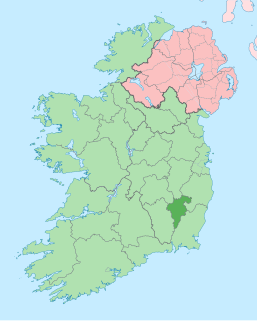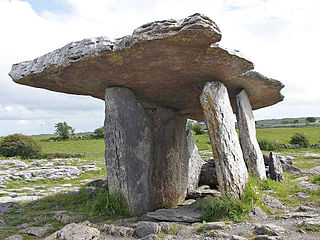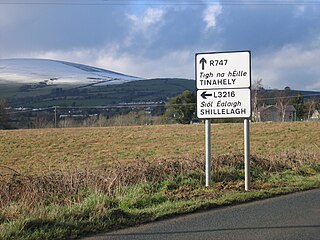| Lorum High Cross | |
|---|---|
| Native name Irish: Ardchros Leamhdhroma | |
Surviving granite shaft of the cross | |
| Location | Lorum, Ballinkillin, County Carlow, Ireland |
| Coordinates | 52°39′51″N6°55′56″W / 52.664028°N 6.932335°W Coordinates: 52°39′51″N6°55′56″W / 52.664028°N 6.932335°W |
Lorum High Cross is a high cross fragment and National Monument located in Lorum, County Carlow, Ireland [1] [2] The cross belongs to an early monastic site which is associated with Molaise of Leighlin. [3] The remaining cross fragment consists of a granite shaft with a height of 55 cm and a width of 30 cm that resides on a small cairn with a diameter of 210 cm. [2]

A high cross or standing cross is a free-standing Christian cross made of stone and often richly decorated. There was a unique Early Medieval tradition in Ireland and Britain of raising large sculpted stone crosses, usually outdoors. These probably developed from earlier traditions using wood, perhaps with metalwork attachments, and earlier pagan Celtic memorial stones; the Pictish stones of Scotland may also have influenced the form. The earliest surviving examples seem to come from the territory of the Anglo-Saxon kingdom of Northumbria, which had been converted to Christianity by Irish missionaries; it remains unclear whether the form first developed in Ireland or Britain.

County Carlow is a county in Ireland, part of the South-East Region and the province of Leinster. It is named after the town of Carlow, which lies on the River Barrow. Carlow County Council is the local authority. The population was 56,932 at the 2016 census.

Ireland, also known as the Republic of Ireland, is a country in north-western Europe occupying 26 of 32 counties of the island of Ireland. The capital and largest city is Dublin, which is located on the eastern part of the island, and whose metropolitan area is home to around a third of the country's over 4.8 million inhabitants. The sovereign state shares its only land border with Northern Ireland, a part of the United Kingdom. It is otherwise surrounded by the Atlantic Ocean, with the Celtic Sea to the south, St George's Channel to the south-east, and the Irish Sea to the east. It is a unitary, parliamentary republic. The legislature, the Oireachtas, consists of a lower house, Dáil Éireann, an upper house, Seanad Éireann, and an elected President who serves as the largely ceremonial head of state, but with some important powers and duties. The head of government is the Taoiseach, who is elected by the Dáil and appointed by the President; the Taoiseach in turn appoints other government ministers.














